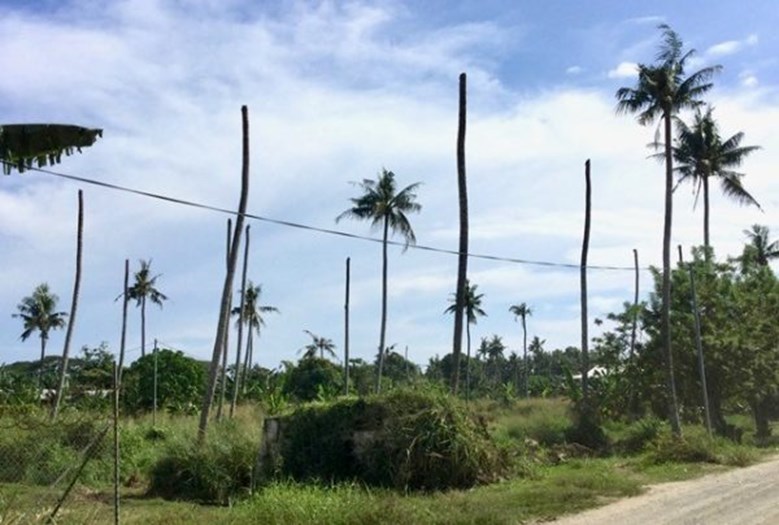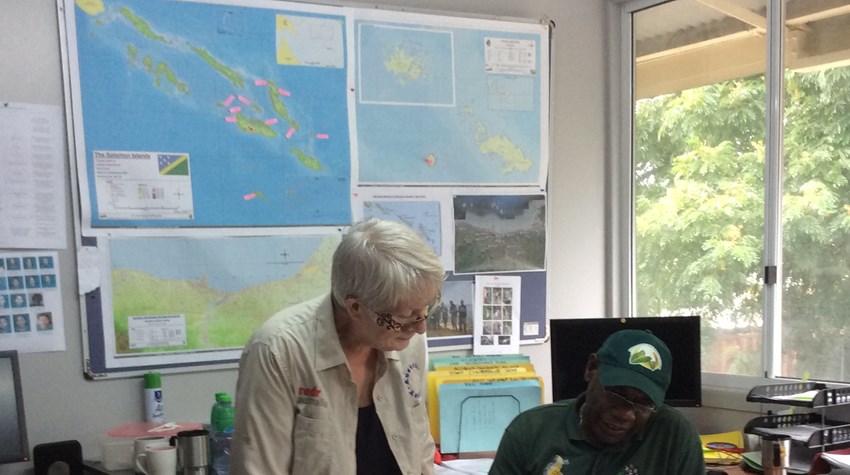Since February, Pamela has been embedded in the Department of Biosecurity within the Government’s Ministry of Agriculture and Livestock. In her role as CRB Strategic Coordinator, Pamela has been working with the Department to control the target strain, which has caused the Solomon Islands Government to declare a national state of emergency.
“My role is to coordinate the entire response to the national emergency which means working with the Response Oversight Committee, the national CRB Taskforce, and on a daily basis, with the Biosecurity Emergency Coordination Centre (BECC),” says Pamela. “I am setting up processes for easier coordination between the teams implementing the response, and ensuring that it is all coordinated in the most cost effective, efficient, and timely manner.”

The Coconut Rhinoceros Beetle (CRB) which is can cause significant damage to coconut palms. Photo credit: Pacific Community (SPC)
In January 2015, Orycytes rhinoceros, commonly known as the Coconut Rhinoceros Beetle, was first identified in the Solomon Islands in Honiara on Guadalcanal. Soon after, it was confirmed to be the CRB-G (Guam) strain, a species resistant to the virus used to control the CRB-S type, also present across the Pacific.
The beetle is a major pest of coconut palms and is causing serious damage to trees across Honiara and Guadalcanal, as well as spreading to other provinces. Because coconut palms are a vital part of the Solomon Islands economy and hold cultural significance, the spread of the pest is threatening livelihoods across the Islands.
“With the current level of destruction, people are not able to buy or sell fresh coconuts and they are not able to provide coconuts for the oil and copra industries. This is impacting people’s ability to send their children to school, buy sufficient food, and have access to medical care,” says Pamela. “Then there is the cultural aspect. Local festivals use coconuts, and there is the impact on infrastructure in terms of access to building materials.”

Photo credit: Pamela George, RedR Australia
As well as daily coordination of the CRB response, a major undertaking of Pamela’s has been assisting in the development of the Three-Year Strategic Plan for the management of CRB. The Plan allows the three main constituents – the Solomon Islands Government, primarily the Department of Biosecurity, the private sector, and the donor community – to be able to understand the current response and what is being planned.
“It includes the history of the incursion, the structure that is in place to respond to the incursion, including all of the legislation, governance, and management structures, and the eradication plan that should be implemented," says Pamela. "It describes achievements to the end of 2018, what is planned for 2019, and then given this information, what are the future plans for 2020 and 2021.”

Damage caused to coconut palms by CRB in Honiara. Photo credit: Bob Macfarlane, Devpolicy Blog
Pamela explains that eradication of the pest is impossible given the breadth of the incursions into the Provinces. However, there are two key control measures for the pest: good coconut plantation maintenance practices, and the identification of improved biological control measures.
“Good coconut plantation measures include ensuring all dead palms are destroyed rather than being left to rot and ensuring chicken manure – the primary breeding ground of CRB – is turned over regularly,” says Pamela. “There’s also ongoing work in the Solomon Islands, Australia and New Zealand to identify improved strains of virus and fungus that can be introduced into the population as a control measure for CRB-G and spread via breeding.”
Scheduled to remain in the Solomon Islands until February next year, Pamela says her primary focus will be on coordinating the response to the CRB-G, but will also look at identifying the lessons learned from the response and adopting a more refined approach for the inevitable future incursions – some of which are present already, such as the Giant African Snail.
“We are looking at establishing an internal quarantine unit within the Department of Biosecurity, making the BECC a permanent sub-unit of that, and aligning it with a surveillance unit and with provincial offices,” Pamela says. “The aim is to work out a new structure within the department to enable a faster and more effective response.”


